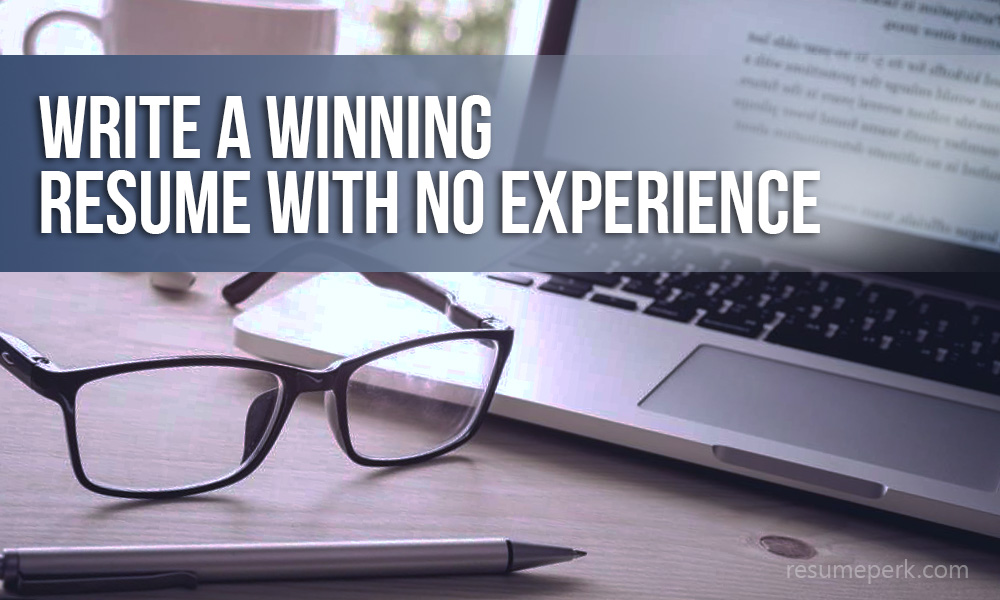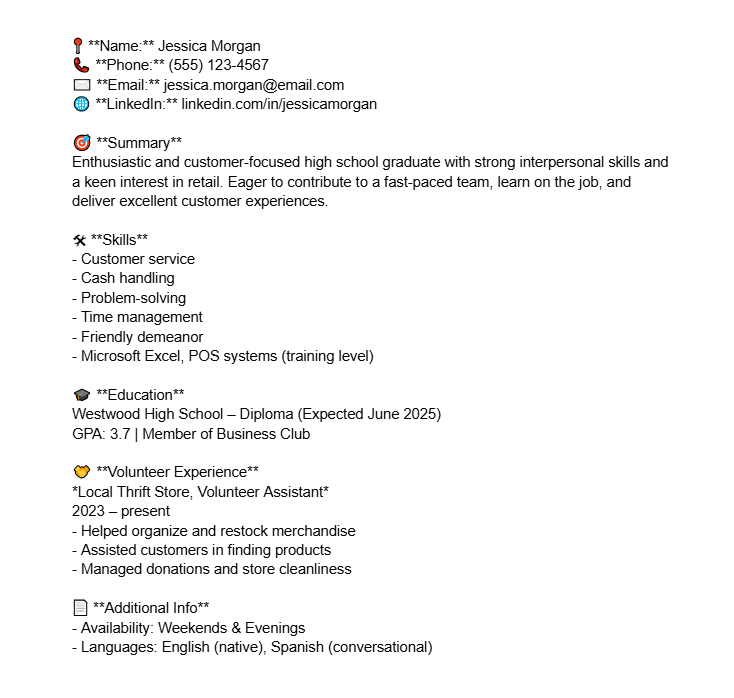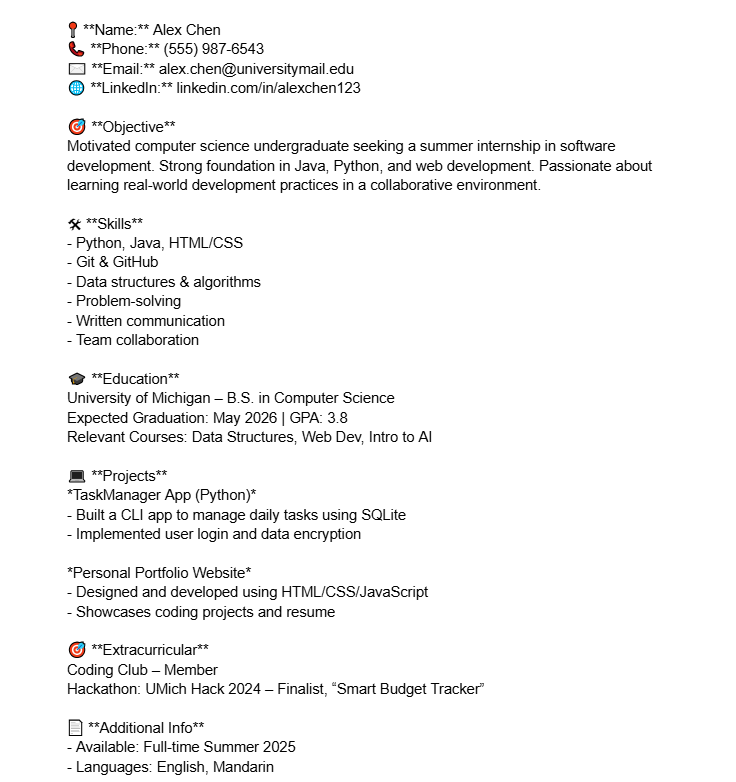How to Make a Resume with No Experience: A Step-by-Step Guide

Written by our professional resume consultants who help entry-level applicants land their first jobs.
Starting your career can feel daunting when your resume feels empty. Having guided countless clients through entry-level applications, I’ll explain how to make a resume with no experience that impresses hiring managers. Need help creating a resume when youre just starting out? Our writers explain how to highlight your strengths even without past jobs.
One of our clients, a recent high-school graduate, used this approach to land a customer-service role.
Why a Great Resume Matters - Even Without Experience
To land your first serious' job, be it a full-time employment after graduation or a part-time job to earn some extra cash, you'll need a good resume. With the growing competition for entry-level job openings, your resume needs to capture the eye in seconds. Otherwise, your chances for an interview will plummet. Even if you have no experience, you need to find a way to list your relevant skills. If you review resume examples, you will see that the education section is always followed by professional experience. However, your job resume can still be impressive even without experience! Don't see how it is possible? Continue reading!
Since you don't have professional experience that speaks for itself, you need a different approach to resume writing. Today, one of our expert writers will share the guide to creating an entry-level resume. We'll show what to highlight in a resume, how to organize the content and eventually increase your chances for an interview. By the way, did you know that February is the best month to find a job? Read more here
Get Professional Help Crafting Your First Resume
When applying for entry-level jobs, you have to compete with your peers and career changers. The entire process of job-hunting might get frustrating as you keep getting rejections. However, quite often the situation can be changed after a simple resume rewriting. At Resumeperk.com, we've been helping students and graduates with resume writing and editing for 10+ years. We offer personal help of your resume assistant who will work on your resume until it's perfect. Moreover, we've set the cheapest prices for college graduates - take advantage of our winter sale and get your resume done with a 20% discount. We know how to prepare a functional resume to impress your potential employer and showcase transferable skills! The professional career coach will choose a proper resume format that aligns your school projects with your career goals.
10 Steps to Write Your First Resume Without Job Experience
Finding the first job with a reputable employer can determine your future career path. That's why it's important to put the extra effort to putting together a catchy, irresistible entry-level resume. The whole period of looking for a first job is full of uncertainty; so why stress yourself out even more with resume writing? Resume writing advice online is often confusing and doesn't make the task any easier.
This structure follows the same method we use when training interns in resume writing workshops.
Luckily, the writing experts of Resumeperk.com are always there for you. Our indispensable academic and business resume writers have organized a set of rules for effective resume creation. Consult the steps below to complete a resume assignment effectively and get noticed from the midst of other millennial job-seekers:
Step 1: Start with Contact Information
Put your full name and contact details at the top of the document. Create a professional email address and don't use fancy email like wholetthedogsout@icloud.com.Georgeorwell@gmail.com is a good example. It seems minor, but a funny email shows lack of professional attitude.
Step 2: Create a short summary of your job experience
Even though you're inexperienced, you certainly have something you could brag in front of a prospective employer. In a student resume summary, you may use relevant hard and soft skills, university achievements and awards, and show your professional passion to make the reader interested. Focus on the competencies that present you as a great cultural fit as well. Explain how the employer would benefit from hiring you.
Step 3: Highlight skills for specific job description
You may not have the relevant experience, but you need to mention that you possess the right skills to succeed if hired. Pro tip: use the skills from a job posting, provided that you have those skills. At the end of this article we'll share a list of skills that hiring managers will be excited to see in an entry-level resume.
Step 4: Proceed to the education section and extracurricular activities
Following the list of skills should be your education. Unless you gain 2 years of experience, your diploma or degree is your biggest asset. Include a school name, a degree, and a graduation year. High GPA (3.5 or higher), academic achievements, rewards, and relevant coursework can be mentioned to add worth to this section. If your major is relevant for the job, listing 6-8 courses are enough. Students with a BS or MS degree can freely omit the high school information (even if you are only working towards a degree and haven't completed all credits yet).
Step 5: Organize your experience
- Here comes the toughest part in student resume writing - the work experience. Each career situation is unique and therefore the approach to writing will vary. However, the below best CV experience examples will help you nail the writing of this section:
- 5.1 Have you had any relevant internship, done voluntary work in your industry, or work on a relevant project in the university? List those experiences as you would describe the full-time job. Write down your responsibilities and results of work. Show how you put your education and skills in action.
- 5.2 Have you worked part-time (i.e. as a waiter, tutor, or brand ambassador)? Include these jobs as well - irrelevant experience is better than none. Think of the skills you've learned and how they can be translated to your target role. Let's say you worked as a bartender - so, you have great verbal communication skills, can resolve conflicts and deliver customer care.
- 5.3 Have you had any menial experience? If you haven't had an employment but babysit your nephew, mowed lawns or helped the father with his own business, you can and should list this as an experience.
Step 6: Include voluntary experience not only in a resume but also in a cover letter
Focusing on a voluntary work is a great strategy for writing a resume for students entering the workforce. Just list this type of experience like you would list a full-time job: organization name, your role, dates, and your responsibilities/achievements.
Step 7: List the training and certifications
If you took some courses or training in addition to working on your major, list them under a specific section in a resume. Moreover, multiple certifications make you a catch for bigger companies who are hunting on the top talent.
Step 8: Take advantage of your hobbies and interests
Like the certification or volunteering, this section isn't a resume must-have. However, it might show the human side of you, and some hiring managers appreciate it. Moreover, you can research the recruiter's profile on social media and include some of the interests they have to create a personal connection. However, in this case, be prepared to talk about them on the interview.
Step 9: Proofread for perfect result
Over 50% of hiring managers reject resumes because of typos and errors. Revise your resume for several times to make sure everything is correct. If your document turned out more than one page (a recommended length for a student resume), clean up lengthy writing. Ideally, find an English proofreader to check the document once again in case you missed something. By the way, an editor of our services can both proofread the text and improve the looks of your resume.
Step 10: Attach a matching cover letter
Cover letter is a lot more than a pure formality - it's a chance to share your personal interest in the industry or company, tell a story or build personal connection with the hiring authority. A good letter needn't be long - four paragraphs are sufficient to portray you as a good fit for the role. An engaging opener matters, though - to create a catchy introduction, read how to start cover letter.
Going through the above tips one by one, you'll manage to create a first resume that represents your background well. You can also browse the first time resumes sample US in the Samples section of our blog. And finally, remember that recruiters don't expect to see years of experience in your resume, but will be thrilled to see your enthusiasm and positive attitude.
Free Resume Templates for Entry-Level Positions: Learn How to Make a Resume with No Experience
These templates were designed by HR experts who regularly review entry-level resumes.
Have no idea how to turn your volunteer experience into technical skills that are needed for your first job resume? Let's take a look at several resume examples for a paid job with key skills. You do not need to copy the format or the wording. However, these examples can help you get a better understanding of the job market and job application expectations.

https://docs.google.com/document/d/1ZbDNq2ILN-JNRvExuAMyFm3OMR4Invt4C37zzSMHr_M/copy

https://docs.google.com/document/d/11Q0T2tCDyIw7uuIaC9vG1xPduEUhOhA5PpvEDdBpERI/copy
Top Skills Employers Look for in Entry-Level Candidates
In every career field, employers look for pretty much similar traits in entry-level applicants. By highlighting the skills suggested below, you'll differentiate yourself from peers and increase your interview chances. So, here are the top skills an entry-level resume should have.
Soft Skills
Soft skills are personal attributes and interpersonal skills that characterize how you work and interact with others.
- Ability to learn on the go - if hired, you'll have to grasp new things from practice rapidly. Show your willingness to learn.
- Communication - interpersonal skills are of great demand in any industry.
- Customer orientation/customer care - point out that you can take your time to understand client needs and then meet them with business goals in mind.
- Dependability - the willingness to show up on time, complete tasks according to deadlines and commit to the organizational success is valued by the recruiters.
- Problem solving - everything that businesses do is basically finding a solution to customer problems. Think of how you resolved problems before (for instance, during your studies).
- Teamwork - show that you work well with others and will deliver great results as part of a group. Tell about an internship where you worked with others to complete a project.
- Positive attitude - ability to handle criticism in a professional manner and openness to new challenges are what the employer expects from you.
Hard Skills
Hard skills are specific, teachable abilities that can be defined and measured.
- MS Office (iWork) skills - these tools are crucial for every workplace, so persuade your employer that you are computer literate and don't need to be taught.
- Programming - the importance of programming skills in all industries will only grow over time, so if you know at least one programming language, do include it into your skill list.
- Social media,if you are familiar with SMM (for instance, you managed a university campus Facebook group), mention this.
Get Expert Feedback on Your Resume
Upload your draft and receive suggestions from our certified resume writers.
Need Help Creating a High-School Resume Without Work Experience?
Our student clients often focus on volunteer work and school projects and that works perfectly for entry applications.
Using the tips and recommendations above, you'll create a resume with ease. However, the biggest challenge with a resume is that you cannot objectively evaluate it. And the hiring manager won't give you a low grade for a poor resume - they'll just put it away and call another candidate. If you want to be 100% sure that your resume is written well, contact our website. At Resumeperk com, we have a huge team of American copywriters and in-house proofreaders. Our experts will create you a winning resume from scratch, or assist with proofreading and revision if you already have one. We take on urgent assignments as well, so if you want a resume by tomorrow, that's not a problem. Help of a professional writer has never been so affordable - learn more about our prices.
Author: Editorial Team at ResumePerk.com
Reviewed by: Certified Career Expert
Last updated: November 2025
Recommended reading:
- Write Your Resume Like an Expert Resume Writer: 10 Tips
- How to Build My Resume Effectively In 10 Simple Steps


